VIS-IR Spectroscopy of Mixtures of Water Ice, Organic Matter, and Opaque Mineral in Support of Small Body Remote Sensing Observations
Abstract
:1. Introduction
2. Methods and Materials
2.1. Materials
- Water-ice particles: these have been prepared by means of the Setup for the Production of Icy Planetary Analogs-B (SPIPA-B, [36,39]), which makes use of an ultrasonic nebulizer and a peristaltic pump to spray and freeze water droplets into liquid nitrogen. This protocol allows us to produce spherical water-ice particles with a reproducible size distribution, characterized by a diameter of 67 ± 31 m, as inferred from cryo-scanning electron microscopy. The reflectance factor (REFF) (which, hereafter, we refer to as reflectance, for brevity) spectrum (Figure 1a) is characterized by high albedo at visual wavelengths and displays the diagnostic near-infrared water ice absorption features located at 1.05, 1.25, 1.5, 2.0, and 2.7–3.0 m. The broad 1.5-m band hosts a secondary absorption at 1.65 m, characteristic of crystalline water ice [50,51]. Longward of the strong 2.7–3.0 m absorption, the Fresnel reflectance peak is clearly displayed at 3.1 m with two side-features at 3.0 m and 3.2 m, still indicative of crystalline water ice [52].
- Kerite: this is a natural solid oil bitumen of medium aromaticity (PAM#42) from the DLR (Deutsches Zentrum für Luft- und Raumfahrt) laboratory repository. The sample was previously part of the H. Jacob collection [53] and originates from Pushmataha County, United States. We refer the reader to [54] for elemental and X-ray diffraction (XRD) analyses (sample #8540) and 0.5–16 m reflectance spectrum of the <25 m-powder (“kerite” in Figure 1 of [54]), while the C neutron magnetic resonance analysis has been published in [55]. In addition, 0.3–25 m reflectance spectra of five dry-sieved kerite PAM#42 separates have been measured in [56], and the detailed results will be published elsewhere. In this work, kerite separates were prepared/available in three different grain sizes (25–50 m, 45–63 m, and <25 m, referred to as kerite, kerite, and kerite, respectively), obtained by manual grinding of the bulk sample and wet-sieving (with water) of the coarse (>25 m) fraction. The kerite sample reflectance spectra are shown in Figure 1b. The three separates are characterized by a marked visual/near-infrared positive spectral slope, which progressively decreases with increasing grain size, along with the overall reflectance, as the effect of increasing light absorption in the grains. A similar trend is seen in the spectra of PAM#42 kerite separates previously measured at DLR [56]. The kerite spectrum displays several absorption features characteristic of solid bitumens, as described in [54]. In particular, in the investigated spectral range, we can recognize a complex feature at 2.3–2.6 m due to the overlapping combinations of mid-infrared fundamental modes of CH and CH groups. Moving to longer wavelengths, several absorptions related to organic OH groups occur at 2.77, 2.90–2.92, 3.02, and 3.14 m. Finally, C-H stretch-related features, which are used as principal indicators of aromatic/aliphatic carbon in VIS-IR spectroscopy, are located at 3.28 m (aromatic CH), ∼3.4 m (likely from superposition of the absorptions at 3.38–3.39 m of antisymmetric modes of aliphatic CH groups and at 3.41–3.42 m of antisymmetric modes of aliphatic CH groups and aromatic CH groups), ∼3.5 m (likely from superposition of the absorptions at 3.48–3.50 m of symmetric modes of aliphatic CH and at 3.50 m of symmetric modes of aliphatic CH), and 3.66–3.67 m (ArCH or RCHO groups).
- Pyrrhotite: we used an iron sulphide (Fe1−xS) sample (PAM#169) from the DLR laboratory repository [56]. Reflectance spectra in the 0.3–25 m spectral range of five PAM#169 size separates ranging from <25 to 250 m have been measured in [56]. It has been shown that reflectance and spectral slopes of the powders decrease with decreasing grain size, making fine-grained pyrrhotite an effective darkening agent. The detailed results will be published elsewhere. We prepared two particulate separates: 25–50 m (pyrrhotite) and <25 m (pyrrhotite). The former separate was produced by manual grinding and wet-sieving (with ethanol instead of water, to avoid sample oxidation), while the fine-grained pyrrhotite has been prepared by hand-crushing followed by colloidal grinding in a planetary grinder [9]. The two pyrrhotite separates display featureless red-sloped VIS-IR spectra (Figure 1c). As observed for other opaque phases where surface scattering dominates [9,57,58], and in [56] for the same sample, reflectance of the pyrrhotite powders decreases with decreasing grain size, with the pyrrhotite separate being ∼5 times darker than the pyrrhotite powder. In this respect, we note that fine-grained iron sulphides have been proposed as darkening materials in cometary surfaces [4,5,9,56].
2.2. Mixtures Preparation
- Water ice–kerite mixtures: these samples were prepared as an intimate mixture (“salt and pepper”). The mixing was performed adopting a protocol aimed at minimizing any modifications of the water ice grains (SPIPA-B) during the sample preparation and described in Section S2 of the Supplementary Material. Two sets of three binary mixtures were produced, by using the kerite and the kerite grains separately and varying the kerite abundance (Figure 2, top panel).
- Water ice–pyrrhotite mixtures: these samples were prepared as intimate and intraparticle mixtures (pyrrhotite fine grains embedded in water ice grains) by using the pyrrhotite and pyrrhotite samples, respectively. Intimate mixtures were prepared following the protocol described in Section S2 of the Supplementary Material. Intraparticle mixtures were produced by preparing a suspension of water and pyrrhotite grains homogenized via ultrasonic mixing (30 s, two times), according to the required mixing ratio, and then by following the protocol for the production of SPIPA-B grains (freezing in liquid N of water droplets with pyrrhotite inclusions). Two sets of three mixtures were prepared, one for each mixing modality (Figure 2, central panel).
- Kerite–pyrrhotite mixtures: two refractory intimate mixtures were prepared by combining the kerite grains and the fine grained pyrrhotite sample (Figure 2, bottom panel).
3. Mixtures Spectral Behavior
3.1. Water Ice–Kerite Mixtures
3.2. Water Ice-Pyrrhotite Intimate Mixtures
3.3. Water Ice–Pyrrhotite Intraparticle Mixtures
3.4. Kerite–Pyrrhotite Intimate Mixtures
4. Spectral Modelling
- We expect a minor contribution to the measured reflectance from the opposition effect, as our measurements are performed at a relatively large phase angle ().
- In Hapke theory, the correction for “large-scale” roughness accounts for the fact that real surfaces, due to local topography, are not necessarily smooth at scales larger than the grain size and smaller than the detector footprint. This would affect the target reflectance, due to varying illumination angles on facets (here it is assumed that a macroscopically rough surface is composed by small surface elements, locally smooth, and large compared to the grain size, referred to as “facets”) with randomly distributed slopes and facet shadowing effects. Although, in principle, this effect should be small in laboratory samples, Ref. [61] showed that roughness at scales from the grain size up to few millimetres may still produce a non-negligible photometric contribution. Nonetheless, our measurements are performed at a relatively small phase angle, suggesting these effects should be minor.
- The effect of porosity in closely packed media on the surface reflectance has been introduced and modelled in [62]. However, unless the porosity is measured independently, in the inversion process, the effects of porosity can possibly be compensated by varying the single scattering albedo [42], thus not allowing us to fully decouple the two quantities. Given this, in many applications of the Hapke model to remote sensing observations, porosity effects are usually not explicitly modelled. We align with this approach in order to test the model in similar conditions of applicability.
4.1. Modelling Intimate Mixtures
4.2. Modelling Intraparticle Mixtures
4.3. Hapke Modelling Results
4.3.1. Water Ice–Kerite Intimate Mixtures
4.3.2. Water Ice–Pyrrhotite Intimate Mixtures
4.3.3. Kerite–Pyrrhotite Intimate Mixtures
4.3.4. Water Ice–Pyrrhotite Intraparticle Mixtures
5. Discussion and Conclusions
- 1.
- We find that minor amounts (≲1 wt%) of aliphatic organics can remain undetected in mixtures with coarse-grained (characteristic size of several tens of microns) water ice if searched by means of the diagnostic absorption features around 3.4 m. A significant reduction of the reflectance level and overall increase of the VIS-IR spectral slope are already noticeable with the lowest organic abundances explored by our experiments, which, however, would not be easy to disentangle from the contribution of other spectrally bland, yet VIS-IR reddish, absorbing materials. Our measurements also suggest that fine-grained fractions of organic materials with intense aliphatic features would be more easily detected than coarse-grained ones with similar abundance when mixed with relatively large water ice grains. This is due to the more favourable grain cross-section/volume ratio and, for the specific kerite sample adopted in this study, to the more intense 3.4-m feature in the spectrum of the kerite separate compared to that of the kerite powder. For the latter separate, the spectral contrast of the feature is reduced by partial saturation of the absorption bands around 3.4 m. Fine-grained insoluble organic matter (IOM) isolated from carbonaceous chondrites is characterized by a much less intense absorption around 3.4 m (band depths <0.12, [64]) compared to the one observed in our kerite separate (∼0.9). Given this, we can anticipate that IOM-like material mixed with coarse-grained water ice would likely be characterized by detectability thresholds significantly larger than the ones obtained in this study.
- 2.
- All the investigated water-ice-bearing mixtures of our experiments are characterized by high water ice content. As a consequence, although a general reduction of the band contrast is observed with increasing abundance of refractories, most of the major water ice spectral features monitored in this study, and in particular the 1.5-m and 2-m bands, always remain clearly detectable. At the same time, with increasing amounts of refractories, the REFF of the mixtures at wavelengths where water ice is brighter than the other (dark) endmember progressively decreases, and for certain cases, it becomes surprisingly lower than the dark endmember REFF. A similar behaviour can be noted for mixtures containing SPIPA-B water ice grains and lunar regolith simulant [36,37]. This indicates that in such mixtures, the final overall reflectance is not necessarily a monotonic function of the endmember mixing ratios and implies that additional properties/effects potentially concur in defining the reflectance level, among which we list porosity and multiple scattering effects in the case of anisotropic SPPFs. This has implications for VIS remote sensing observations of water-ice-bearing surfaces, where the albedo is commonly considered as an indicator of water ice content. Our measurements, in addition to [36,37], indicate that VIS albedo is not necessarily a good proxy for characterizing water ice abundance, and considerable amounts of water ice may be overlooked based only on this indicator. Conversely, spectral indicators such as water ice band depths and spectral slopes, in general, appear mostly monotonically linked to the water ice abundance, providing more robust constraints. We also note that a similar reflectance behaviour was observed for the two kerite-pyrrhotite mixtures, suggesting that analogue effects may be relevant for refractory mixtures as well.
- 3.
- Our measurements show that intraparticle mixing of fine opaque inclusions in coarse-grained water ice is extremely efficient at VIS-IR darkening. In fact, we find that 5 wt% fine-grained pyrrhotite inclusions are capable of reducing the VIS REFF of pure water ice by a factor of ∼40. Similar strong darkening effects were reported by [38] by using nanophase carbon inclusions in coarse water ice grains. Such levels of REFF (∼0.02 at VIS wavelengths for the 5 wt%-pyrrhotite case) would be comparable with the characteristic low albedo of cometary nuclei [2,3,78,79,80,81] at VIS wavelengths. However, reflectance spectra of our mixtures display clearly detectable water ice absorption features, a prominent Fresnel peak, and neutral to negative spectral slope, not observed in cometary VIS-IR spectra [3,6,81], thus ruling out a similar mixing modality as a reference paradigm for the average surface properties of these objects.
- 4.
- The comparison of the spectral output of our binary intimate mixtures with a simplified semi-empirical version of the Hapke model provides overall positive results with most of the mixtures fitted with an NRMSD ≤ 10% and a minimum number of free parameters. Nonetheless, retrieved abundances, although positively correlated with the corresponding endmember mixing ratios, are offset from nominal values. The analysis of SEM images suggests that a simplistic assumption on the typical grain size of the investigated endmembers (central value from the size limits imposed by the sieving procedures) can considerably overestimate the effective grain size of irregular (not equant) grains (Equation (6)) and of fine-grained fractions, and possibly explain the observed mismatch on the retrieved abundances. In particular, within each set of water-ice-bearing mixtures, we find that similar adjusted grain sizes () of the refractory endmember provide the correct mixing ratios, indicating a systematic and reproducible effect, and suggesting that the estimated values approximate the sample effective grain size. Similarly, in the case of the pyrrhotite-kerite mixtures, we find that the correct mixture abundances are obtained by similar adjusted grain size ratios of the two endmembers. Our results are qualitatively similar to the ones from [37], who modelled monochromatic reflectance measurements of water ice–lunar simulant mixtures, and provide additional support to the argument of accounting for grain shape effects in spectral un-mixing attempts [37,63].
- 5.
- The modelling of water ice–pyrrhotite intraparticle mixtures with the LR11 model [46] provided overall encouraging results and a much better agreement than the EMT-based approach [45,72]. This is compatible with the fact that the pyrrhotite inclusion size is not negligible with respect to wavelength, as instead assumed by the EMT-based approach. The LR11 approach was originally developed to model the effects of submicrometre iron inclusions in mineral grains to characterize space weathering effects on planetary surfaces ([46], and references therein). Our results indicate that it can also be adopted to model intraparticle mixtures hosted in water ice grains and suggest it can be applied to different classes of endmembers.
Supplementary Materials
Author Contributions
Funding
Data Availability Statement
Acknowledgments
Conflicts of Interest
Appendix A
| Band Reference Wavelength | Left Shoulder | Right Shoulder |
|---|---|---|
| 1.25 m | 1.14 m | 1.34 m |
| 1.5 m | 1.36 m | 1.84 m |
| 1.65 m | 1.62 m | 1.75 m |
| 2 m | 1.84 m | 2.24 m |
| Band Reference Wavelength | Left Shoulder | Right Shoulder |
|---|---|---|
| 3.28 m | 3.20 m | 3.34 m |
| 3.4 m | 3.32 m | 3.48(3.46) m |
| 3.5 m | 3.48(3.46) m | 3.60(3.62) m |
| 3.4 m (complex) | 3.22 m | 3.64 m |
Appendix B. Water Ice (95 wt%)–Pyrrhotite <25 (5 wt%) Intraparticle Mixture: Correction of the Spectral Contribution from Sublimating Frost

Appendix C. Multiple Scattering Effects Coupled to Anisotropic SPPFs Explored by Monte Carlo Ray-Tracing
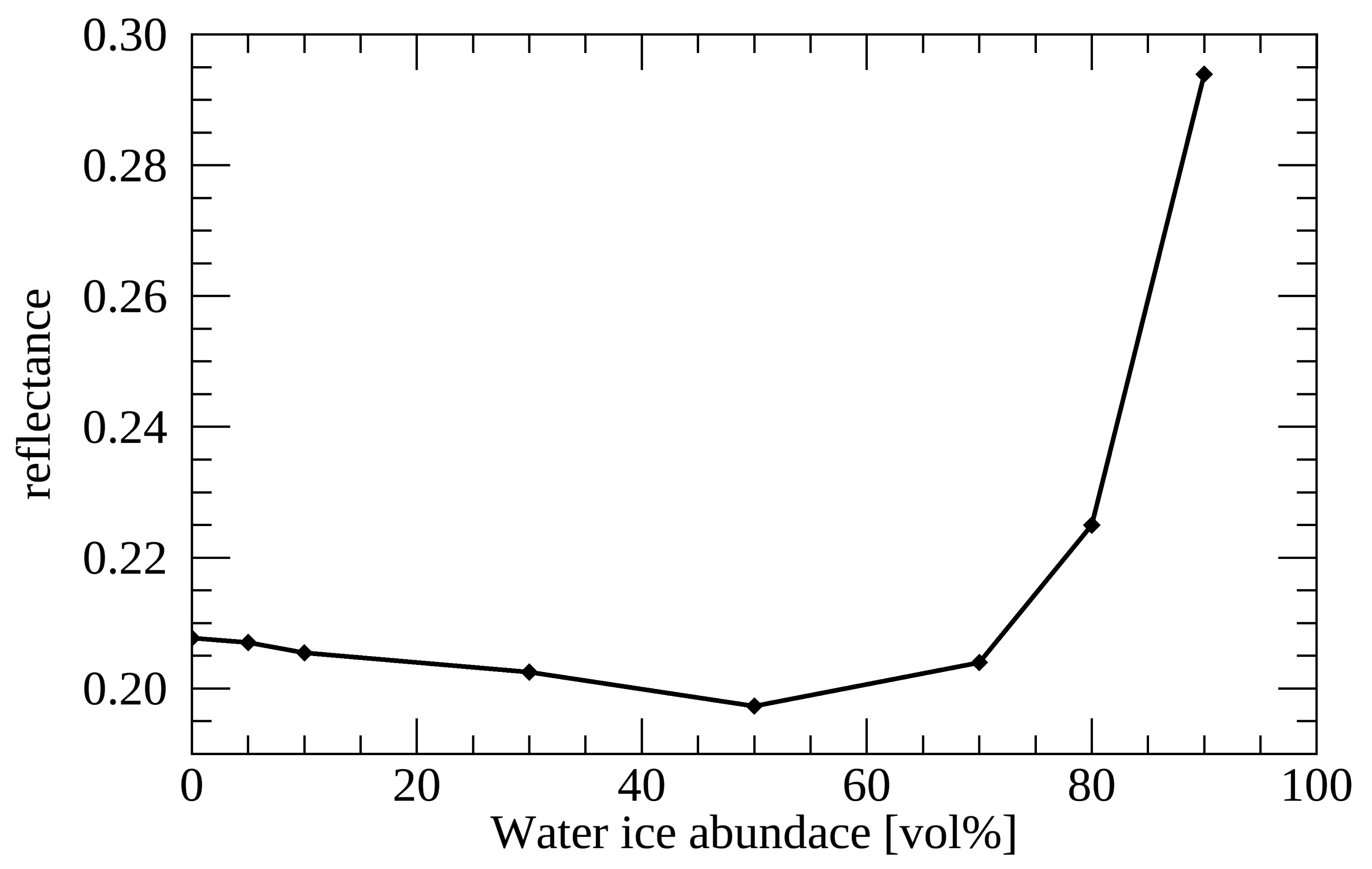

References
- Taylor, M.G.G.T.; Altobelli, N.; Buratti, B.J.; Choukroun, M. The Rosetta mission orbiter science overview: The comet phase. Philos. Trans. R. Soc. Lond. Ser. A 2017, 375, 20160262. [Google Scholar] [CrossRef] [Green Version]
- Ciarniello, M.; Capaccioni, F.; Filacchione, G.; Raponi, A.; Tosi, F.; De Sanctis, M.C.; Capria, M.T.; Erard, S.; Bockelee-Morvan, D.; Leyrat, C.; et al. Photometric properties of comet 67P/Churyumov-Gerasimenko from VIRTIS-M onboard Rosetta. Astron. Astrophys. 2015, 583, A31. [Google Scholar]
- Fornasier, S.; Hasselmann, P.H.; Barucci, M.A.; Feller, C.; Besse, S.; Leyrat, C.; Lara, L.; Gutierrez, P.J.; Oklay, N.; Tubiana, C.; et al. Spectrophotometric properties of the nucleus of comet 67P/Churyumov-Gerasimenko from the OSIRIS instrument onboard the ROSETTA spacecraft. Astron. Astrophys. 2015, 583, A30. [Google Scholar] [CrossRef] [Green Version]
- Capaccioni, F.; Coradini, A.; Filacchione, G.; Erard, S.; Arnold, G.; Drossart, P.; De Sanctis, M.C.; Bockelee-Morvan, D.; Capria, M.T.; Tosi, F.; et al. The organic-rich surface of comet 67P/Churyumov-Gerasimenko as seen by VIRTIS/Rosetta. Science 2015, 347, 628. [Google Scholar] [CrossRef] [Green Version]
- Quirico, E.; Moroz, L.V.; Schmitt, B.; Arnold, G.; Faure, M.; Beck, P.; Bonal, L.; Ciarniello, M.; Capaccioni, F.; Filacchione, G.; et al. Refractory and semi-volatile organics at the surface of comet 67P/Churyumov-Gerasimenko: Insights from the VIRTIS/Rosetta imaging spectrometer. Icarus 2016, 272, 32–47. [Google Scholar] [CrossRef] [Green Version]
- Raponi, A.; Ciarniello, M.; Capaccioni, F.; Mennella, V.; Filacchione, G.; Vinogradoff, V.; Poch, O.; Beck, P.; Quirico, E.; De Sanctis, M.C.; et al. Infrared detection of aliphatic organics on a cometary nucleus. Nat. Astron. 2020, 4, 500–505. [Google Scholar] [CrossRef]
- Poch, O.; Istiqomah, I.; Quirico, E.; Beck, P.; Schmitt, B.; Theulé, P.; Faure, A.; Hily-Blant, P.; Bonal, L.; Raponi, A.; et al. Ammonium salts are a reservoir of nitrogen on a cometary nucleus and possibly on some asteroids. Science 2020, 367, aaw7462. [Google Scholar] [CrossRef]
- Mennella, V.; Ciarniello, M.; Raponi, A.; Capaccioni, F.; Filacchione, G.; Suhasaria, T.; Popa, C.; Kappel, D.; Moroz, L.; Vinogradoff, V.; et al. Hydroxylated Mg-rich Amorphous Silicates: A New Component of the 3.2 μm Absorption Band of Comet 67P/Churyumov-Gerasimenko. Astrophys. J. Lett. 2020, 897, L37. [Google Scholar] [CrossRef]
- Rousseau, B.; Érard, S.; Beck, P.; Quirico, É.; Schmitt, B.; Brissaud, O.; Montes-Hernandez, G.; Capaccioni, F.; Filacchione, G.; Bockelée-Morvan, D.; et al. Laboratory simulations of the Vis-NIR spectra of comet 67P using sub-μm sized cosmochemical analogues. Icarus 2018, 306, 306–318. [Google Scholar] [CrossRef] [Green Version]
- Filacchione, G.; Raponi, A.; Capaccioni, F.; Ciarniello, M.; Tosi, F.; Capria, M.T.; De Sanctis, M.C.; Migliorini, A.; Piccioni, G.; Cerroni, P.; et al. Seasonal exposure of carbon dioxide ice on the nucleus of comet 67P/Churyumov-Gerasimenko. Science 2016, 354, 1563–1566. [Google Scholar] [CrossRef] [Green Version]
- Barucci, M.A.; Filacchione, G.; Fornasier, S.; Raponi, A.; Deshapriya, J.D.P.; Tosi, F.; Feller, C.; Ciarniello, M.; Sierks, H.; Capaccioni, F.; et al. Detection of exposed H2O ice on the nucleus of comet 67P/Churyumov-Gerasimenko. as observed by Rosetta OSIRIS and VIRTIS instruments. Astron. Astrophys. 2016, 595, A102. [Google Scholar] [CrossRef] [Green Version]
- Raponi, A.; Ciarniello, M.; Capaccioni, F.; Filacchione, G.; Tosi, F.; De Sanctis, M.C.; Capria, M.T.; Barucci, M.A.; Longobardo, A.; Palomba, E.; et al. The temporal evolution of exposed water ice-rich areas on the surface of 67P/Churyumov-Gerasimenko: Spectral analysis. Mon. Not. R. Astron. Soc. 2016, 462, S476–S490. [Google Scholar] [CrossRef] [Green Version]
- O’Rourke, L.; Heinisch, P.; Blum, J.; Fornasier, S.; Filacchione, G.; Van Hoang, H.; Ciarniello, M.; Raponi, A.; Gundlach, B.; Blasco, R.A.; et al. The Philae lander reveals low-strength primitive ice inside cometary boulders. Nature 2020, 586, 697–701. [Google Scholar] [CrossRef]
- De Sanctis, M.C.; Capaccioni, F.; Ciarniello, M.; Filacchione, G.; Formisano, M.; Mottola, S.; Raponi, A.; Tosi, F.; Bockelée-Morvan, D.; Erard, S.; et al. The diurnal cycle of water ice on comet 67P/Churyumov-Gerasimenko. Nature 2015, 525, 500–503. [Google Scholar] [CrossRef]
- Ciarniello, M.; Raponi, A.; Capaccioni, F.; Filacchione, G.; Tosi, F.; De Sanctis, M.C.; Kappel, D.; Rousseau, B.; Arnold, G.; Capria, M.T.; et al. The global surface composition of 67P/Churyumov-Gerasimenko nucleus by Rosetta/VIRTIS. II) Diurnal and seasonal variability. Mon. Not. R. Astron. Soc. 2016, 462, S443–S458. [Google Scholar] [CrossRef]
- Fornasier, S.; Mottola, S.; Keller, H.U.; Barucci, M.A.; Davidsson, B.; Feller, C.; Deshapriya, J.D.P.; Sierks, H.; Barbieri, C.; Lamy, P.L.; et al. Rosetta’s comet 67P/Churyumov-Gerasimenko sheds its dusty mantle to reveal its icy nature. Science 2016, 354, 1566–1570. [Google Scholar] [CrossRef] [Green Version]
- Campins, H.; Hargrove, K.; Pinilla-Alonso, N.; Howell, E.S.; Kelley, M.S.; Licandro, J.; Mothé-Diniz, T.; Fernández, Y.; Ziffer, J. Water ice and organics on the surface of the asteroid 24 Themis. Nature 2010, 464, 1320–1321. [Google Scholar] [CrossRef]
- Rivkin, A.S.; Emery, J.P. Detection of ice and organics on an asteroidal surface. Nature 2010, 464, 1322–1323. [Google Scholar] [CrossRef]
- Licandro, J.; Campins, H.; Kelley, M.; Hargrove, K.; Pinilla-Alonso, N.; Cruikshank, D.; Rivkin, A.S.; Emery, J. (65) Cybele: Detection of small silicate grains, water-ice, and organics. Astron. Astrophys. 2011, 525, A34. [Google Scholar] [CrossRef] [Green Version]
- Combe, J.P.; McCord, T.B.; Tosi, F.; Ammannito, E.; Carrozzo, F.G.; De Sanctis, M.C.; Raponi, A.; Byrne, S.; Landis, M.E.; Hughson, K.H.G.; et al. Detection of local H2O exposed at the surface of Ceres. Science 2016, 353, aaf3010. [Google Scholar] [CrossRef]
- Raponi, A.; De Sanctis, M.C.; Frigeri, A.; Ammannito, E.; Ciarniello, M.; Formisano, M.; Combe, J.P.; Magni, G.; Tosi, F.; Carrozzo, F.G.; et al. Variations in the amount of water ice on Ceres’ surface suggest a seasonal water cycle. Sci. Adv. 2018, 4, eaao3757. [Google Scholar] [CrossRef] [Green Version]
- De Sanctis, M.C.; Ammannito, E.; Raponi, A.; Marchi, S.; McCord, T.B.; McSween, H.Y.; Capaccioni, F.; Capria, M.T.; Carrozzo, F.G.; Ciarniello, M.; et al. Ammoniated phyllosilicates with a likely outer Solar System origin on (1) Ceres. Nature 2015, 528, 241–244. [Google Scholar]
- Filacchione, G.; Capaccioni, F.; Ciarniello, M.; Clark, R.N.; Cuzzi, J.N.; Nicholson, P.D.; Cruikshank, D.P.; Hedman, M.M.; Buratti, B.J.; Lunine, J.I.; et al. Saturn’s icy satellites and rings investigated by Cassini–VIMS: III—Radial compositional variability. Icarus 2012, 220, 1064–1096. [Google Scholar] [CrossRef] [Green Version]
- Cruikshank, D.P.; Dalle Ore, C.M.; Clark, R.N.; Pendleton, Y.J. Aromatic and aliphatic organic materials on Iapetus: Analysis of Cassini VIMS data. Icarus 2014, 233, 306–315. [Google Scholar] [CrossRef]
- Poulet, F.; Cuzzi, J.N.; Cruikshank, D.P.; Roush, T.L.; Dalle Ore, C.M. Comparison between the Shkuratov and Hapke scattering theories for solid planetary surfaces: Application to the surface composition of two Centaurus. Icarus 2002, 160, 313–324. [Google Scholar]
- Filacchione, G.; Ciarniello, M.; Capaccioni, F.; Clark, R.N.; Nicholson, P.D.; Hedman, M.M.; Cuzzi, J.N.; Cruikshank, D.P.; Dalle Ore, C.M.; Brown, R.H.; et al. Cassini-VIMS observations of Saturn’s main rings: I. Spectral properties and temperature radial profiles variability with phase angle and elevation. Icarus 2014, 241, 45–65. [Google Scholar] [CrossRef]
- Ciarniello, M.; Capaccioni, F.; Filacchione, G.; Clark, R.; Cruikshank, D.; Cerroni, P.; Coradini, A.; Brown, R.; Buratti, B.; Tosi, F.; et al. Hapke modeling of Rhea surface properties through Cassini-VIMS spectra. Icarus 2011, 214, 541–555. [Google Scholar] [CrossRef] [Green Version]
- Poulet, F.; Cruikshank, D.P.; Cuzzi, J.N.; Roush, T.L.; G, F.R. Compositions of Saturn’s rings A, B, and C from high resolution near-infrared spectroscopic observations. Astron. Astrophys. 2003, 412, 305–316. [Google Scholar]
- Cuzzi, J.N.; French, R.G.; Hendrix, A.R.; Olson, D.M.; Roush, T.; Vahidinia, S. HST-STIS spectra and the redness of Saturn’s rings. Icarus 2018, 309, 363–388. [Google Scholar] [CrossRef]
- Ciarniello, M.; Filacchione, G.; D’Aversa, E.; Capaccioni, F.; Nicholson, P.D.; Cuzzi, J.N.; Clark, R.N.; Hedman, M.M.; Dalle Ore, C.M.; Cerroni, P.; et al. Cassini-VIMS observations of Saturn’s main rings: II. A spectrophotometric study by means of Monte Carlo ray-tracing and Hapke’s theory. Icarus 2019, 317, 242–265. [Google Scholar] [CrossRef]
- McCord, T.B.; Carlson, R.; Smythe, W.; Hansen, G.; Clark, R.; Hibbitts, C.; Fanale, F.; Granahan, J.; Segura, M.; Matson, D.; et al. Organics and other molecules in the surfaces of Callisto and Ganymede. Science 1997, 278, 271–275. [Google Scholar] [CrossRef]
- McCord, T.B.; Hansen, G.B.; Clark, R.N.; Martin, P.D.; Hibbitts, C.A.; Fanale, F.P.; Granahan, J.C.; Segura, M.; Matson, D.L.; Johnson, T.V.; et al. Non-water-ice constituents in the surface material of the icy Galilean satellites from the Galileo near-infrared mapping spectrometer investigation. J. Geophys. Res. Planets 1998, 103, 8603–8626. [Google Scholar] [CrossRef]
- Grundy, W. Is the missing ultra-red material colorless ice? Icarus 2009, 199, 560–563. [Google Scholar] [CrossRef] [Green Version]
- Clark, R.N.; Lucey, P.G. Spectral properties of ice-particulate mixtures and implications for remote sensing. 1. Intimate mixtures. J. Geophys. Res. Planets 1984, 89, 6341–6348. [Google Scholar] [CrossRef]
- Clark, R.N.; Cruikshank, D.P.; Jaumann, R.; Brown, R.H.; Stephan, K.; Dalle Ore, C.M.; Eric Livo, K.; Pearson, N.; Curchin, J.M.; Hoefen, T.M.; et al. The surface composition of Iapetus: Mapping results from Cassini VIMS. Icarus 2012, 218, 831–860. [Google Scholar] [CrossRef]
- Pommerol, A.; Jost, B.; Poch, O.; Yoldi, Z.; Brouet, Y.; Gracia-Berná, A.; Cerubini, R.; Galli, A.; Wurz, P.; Gundlach, B.; et al. Experimenting with Mixtures of Water Ice and Dust as Analogues for Icy Planetary Material. Recipes from the Ice Laboratory at the University of Bern. Space Sci. Rev. 2019, 215, 37. [Google Scholar] [CrossRef]
- Yoldi, Z.; Pommerol, A.; Jost, B.; Poch, O.; Gouman, J.; Thomas, N. VIS-NIR reflectance of water ice/regolith analogue mixtures and implications for the detectability of ice mixed within planetary regoliths. Geophys. Res. Lett. 2015, 42, 6205–6212. [Google Scholar] [CrossRef] [Green Version]
- Jost, B.; Pommerol, A.; Poch, O.; Brouet, Y.; Fornasier, S.; Carrasco, N.; Szopa, C.; Thomas, N. Bidirectional reflectance of laboratory cometary analogues to interpret the spectrophotometric properties of the nucleus of comet 67P/Churyumov-Gerasimenko. Planet. Space Sci. 2017, 148, 1–11. [Google Scholar] [CrossRef]
- Poch, O.; Pommerol, A.; Jost, B.; Carrasco, N.; Szopa, C.; Thomas, N. Sublimation of water ice mixed with silicates and tholins: Evolution of surface texture and reflectance spectra, with implications for comets. Icarus 2016, 267, 154–173. [Google Scholar] [CrossRef]
- Jost, B.; Pommerol, A.; Poch, O.; Yoldi, Z.; Fornasier, S.; Hasselmann, P.H.; Feller, C.; Carrasco, N.; Szopa, C.; Thomas, N. Bidirectional reflectance and VIS-NIR spectroscopy of cometary analogues under simulated space conditions. Planet. Space Sci. 2017, 145, 14–27. [Google Scholar] [CrossRef] [Green Version]
- Yoldi, Z.; Pommerol, A.; Poch, O.; Thomas, N. Reflectance study of ice and Mars soil simulant associations—I. H2O ice. Icarus 2021, 358, 114169. [Google Scholar] [CrossRef]
- Hapke, B. Theory of Reflectance and Emittance Spectroscopy; Cambridge University Press: Cambridge, UK, 2012. [Google Scholar]
- Shkuratov, Y.; Starukhina, L.; Hoffmann, H.; Arnold, G. A model of spectral albedo of particulate surfaces: Implications for optical properties of the Moon. Icarus 1999, 137, 235–246. [Google Scholar]
- Markkanen, J.; Agarwal, J. Scattering, absorption, and thermal emission by large cometary dust particles: Synoptic numerical solution. Astron. Astrophys. 2019, 631, A164. [Google Scholar] [CrossRef] [Green Version]
- Bohren, C.F.; Huffman, D.R. Absorption and Scattering of Light by Small Particles; John Wiley & Sons, Inc.: New York, NY, USA, 1983. [Google Scholar]
- Lucey, P.G.; Riner, M.A. The optical effects of small iron particles that darken but do not redden: Evidence of intense space weathering on Mercury. Icarus 2011, 212, 451–462. [Google Scholar] [CrossRef]
- Brissaud, O.; Schmitt, B.; Bonnefoy, N.; Douté, S.; Rabou, P.; Grundy, W.; Fily, M. Spectrogonio Radiometer for the Study of the Bidirectional Reflectance and Polarization Functions of Planetary Surfaces. 1. Design and Tests. Appl. Opt. 2004, 43, 1926–1937. [Google Scholar] [CrossRef]
- Grisolle, F. Les Condensats Saisonniers de Mars: Etudeexpérimentale de la Formation et du Métamorphisme Deglaces de CO2. Ph.D. Thesis, Université de Grenoble, Grenoble, France, December 2013. [Google Scholar]
- Potin, S.; Brissaud, O.; Beck, P.; Schmitt, B.; Magnard, Y.; Correia, J.J.; Rabou, P.; Jocou, L. SHADOWS: A spectro-gonio radiometer for bidirectional reflectance studies of dark meteorites and terrestrial analogs: Design, calibrations, and performances on challenging surfaces. Appl. Opt. 2018, 57, 8279. [Google Scholar] [CrossRef] [Green Version]
- Grundy, W.M.; Schmitt, B. The temperature-dependent near-infrared absorption spectrum of hexagonal H2O ice. J. Geophys. Res. 1998, 103, 25809–25822. [Google Scholar] [CrossRef]
- Mastrapa, R.; Bernstein, M.; Sandford, S.; Roush, T.; Cruikshank, D.; Ore, C.D. Optical constants of amorphous and crystalline H2O-ice in the near infrared from 1.1 to 2.6 μm. Icarus 2008, 197, 307–320. [Google Scholar] [CrossRef]
- Mastrapa, R.; Sandford, S.A.; Roush, T.L.; Cruikshank, D.P.; Ore, C.M.D. Optical constants of amorphous, crystalline H2O-ice: 2.5–22 μm (4000-455 cm−1) optical constants of H2O-ice. Astrophys. J. 2009, 701, 1347–1356. [Google Scholar]
- Jacob, H. Neuere Untersuchungen zur Genesis natürlicher, fester Erdölbitumina. Geol. Jahr 1983, D 59, 3–61. [Google Scholar]
- Moroz, L.V.; Arnold, G.; Korochantsev, A.V.; Wäsch, R. Natural Solid Bitumens as Possible Analogs for Cometary and Asteroid Organics:. 1. Reflectance Spectroscopy of Pure Bitumens. Icarus 1998, 134, 253–268. [Google Scholar] [CrossRef]
- Moroz, L.; Baratta, G.; Strazzulla, G.; Starukhina, L.; Dotto, E.; Barucci, M.A.; Arnold, G.; Distefano, E. Optical alteration of complex organics induced by ion irradiation:. 1. Laboratory experiments suggest unusual space weathering trend. Icarus 2004, 170, 214–228. [Google Scholar] [CrossRef]
- Moroz, L.V.; Markus, K.; Arnold, G.; Henkel, D.; Kappel, D.; Schade, U.; Ciarniello, M.; Rousseau, B.; Quirico, E.; Schmitt, B.; et al. Laboratory spectral reflectance studies aimed at providing clues to composition of refractory phases of comet 67P/CG’s nucleus. In Proceedings of the European Planetary Science Congress (EPSC2017), Riga, Latvia, 17–22 September 2017; p. 266. [Google Scholar]
- Britt, D.T.; Bell, J.F.; Haack, H.; Scott, E.R.D. The Reflectance Spectrum of Troilite. In Lunar and Planetary Science Conference; Technical Report; Lunar and Planetary Inst.: Houston, TX, USA, 1992; Volume 23. [Google Scholar]
- Cloutis, E.A.; Sanchez, J.A.; Reddy, V.; Gaffey, M.J.; Binzel, R.P.; Burbine, T.H.; Hardersen, P.S.; Hiroi, T.; Lucey, P.G.; Sunshine, J.M.; et al. Olivine-metal mixtures: Spectral reflectance properties and application to asteroid reflectance spectra. Icarus 2015, 252, 39–82. [Google Scholar] [CrossRef]
- Clark, R.N.; Curchin, J.M.; Jaumann, R.; Cruikshank, D.P.; Brown, R.H.; Hoefen, T.M.; Stephan, K.; Moore, J.M.; Buratti, B.J.; Baines, K.H.; et al. Compositional mapping of Saturn’s satellite Dione with Cassini VIMS and implications of dark material in the Saturn system. Icarus 2008, 193, 372–386. [Google Scholar] [CrossRef]
- Chandrasekhar, S. Radiative Transfer; Dover: New York, NY, USA, 1960. [Google Scholar]
- Shepard, M.K.; Helfenstein, P. A test of the Hapke photometric model. J. Geophys. Res. 2007, 112. [Google Scholar] [CrossRef] [Green Version]
- Hapke, B. Bidirectional reflectance spectroscopy: 6. Effects of porosity. Icarus 2008, 195, 918–926. [Google Scholar] [CrossRef] [Green Version]
- Hiroi, T.; Pieters, C.M. Effects of grain size and shape in modeling reflectance spectra of mineral mixtures. Lunar Planet. Sci. Conf. Proc. 1992, 22, 313–325. [Google Scholar]
- Kaplan, H.H.; Milliken, R.E.; Alexander, C.M.O. New Constraints on the Abundance and Composition of Organic Matter on Ceres. Geophys. Res. Lett. 2018, 45, 5274–5282. [Google Scholar] [CrossRef] [Green Version]
- Raponi, A.; Carrozzo, F.G.; Zambon, F.; De Sanctis, M.C.; Ciarniello, M.; Frigeri, A.; Ammannito, E.; Tosi, F.; Combe, J.P.; Longobardo, A.; et al. Mineralogical mapping of Coniraya quadrangle of the dwarf planet Ceres. Icarus 2019, 318, 99–110. [Google Scholar] [CrossRef]
- Mustard, J.F.; Pieters, C.M. Photometric phase functions of common geologic minerals and applications to quantitative analysis of mineral mixture reflectance spectra. J. Geophys. Res. 1989, 94, 13619–13634. [Google Scholar] [CrossRef]
- Carli, C.; Ciarniello, M.; Capaccioni, F.; Serventi, G.; Sgavetti, M. Spectral variability of plagioclase-mafic mixtures (2): Investigation of the optical constant and retrieved mineral abundance dependence on particle size distribution. Icarus 2014, 235, 207–219. [Google Scholar] [CrossRef]
- Ciarniello, M.; Capaccioni, F.; Filacchione, G. A test of Hapke’s model by means of Monte Carlo ray-tracing. Icarus 2014, 237, 293–305. [Google Scholar] [CrossRef]
- Raponi, A.; De Sanctis, M.C.; Carrozzo, F.G.; Ciarniello, M.; Castillo-Rogez, J.C.; Ammannito, E.; Frigeri, A.; Longobardo, A.; Palomba, E.; Tosi, F.; et al. Mineralogy of Occator crater on Ceres and insight into its evolution from the properties of carbonates, phyllosilicates, and chlorides. Icarus 2019, 320, 83–96. [Google Scholar] [CrossRef]
- Hapke, B. Space weathering from Mercury to the asteroid belt. J. Geophys. Res. 2001, 106, 10039–10074. [Google Scholar] [CrossRef]
- Lucey, P.G.; Noble, S.K. Experimental test of a radiative transfer model of the optical effects of space weathering. Icarus 2008, 197, 348–353. [Google Scholar] [CrossRef]
- Maxwell-Garnett, J. Colours in metal glasses and in metallic films. Philos. Trans. R. Soc. Lond. Ser. A 1904, 203, 385–420. [Google Scholar]
- Hapke, B. Bidirectional reflectance spectroscopy. 1. Theory. J. Geophys. Res. Planets 1981, 86, 4571–4586. [Google Scholar]
- Mie, G. Beiträge zur Optik trüber Medien, speziell kolloidaler Metallösungen. Ann. Phys. 1908, 377–445, 377–445. [Google Scholar]
- Haynes, W.M.; Lide, D.R.; Bruno, T.J. CRC Handbook of Chemistry and Physics: A Ready-Reference Book of Chemical and Physical Data, 97th ed.; CRC Press: Boca Raton, FL, USA, 2016. [Google Scholar]
- Röseler, A.; Schade, U. Polarizing interferometer for the unambiguous determination of the ellipsometric parameters. Appl. Opt. 2020, 59, 6619–6624. [Google Scholar] [CrossRef]
- Egan, W.G.; Hilgeman, T. The rings of Saturn—A frost-coated semiconductor. Icarus 1977, 30, 413–421. [Google Scholar] [CrossRef]
- Li, J.Y.; A’Hearn, M.F.; Belton, M.J.S.; Crockett, C.J.; Farnham, T.L.; Lisse, C.M.; McFadden, L.A.; Meech, K.J.; Sunshine, J.M.; Thomas, P.C.; et al. Deep Impact photometry of Comet 9P/Tempel 1. Icarus 2007, 187, 41–55. [Google Scholar] [CrossRef]
- Li, J.Y.; A’Hearn, M.F.; McFadden, L.A.; Belton, M.J.S. Photometric analysis and disk-resolved thermal modeling of Comet 19P/Borrelly from Deep Space 1 data. Icarus 2007, 188, 195–211. [Google Scholar] [CrossRef]
- Li, J.Y.; A’Hearn, M.F.; Farnham, T.L.; McFadden, L.A. Photometric analysis of the nucleus of Comet 81P/Wild 2 from Stardust images. Icarus 2009, 204, 209–226. [Google Scholar] [CrossRef]
- Li, J.Y.; Besse, S.; A’Hearn, M.F.; Belton, M.J.S.; Bodewits, D.; Farnham, T.L.; Klaasen, K.P.; Lisse, C.M.; Meech, K.J.; Sunshine, J.M.; et al. Photometric properties of the nucleus of Comet 103P/Hartley 2. Icarus 2013, 222, 559–570. [Google Scholar] [CrossRef]
- Henyey, L.G.; Greenstein, J.L. Diffuse radiation in the Galaxy. Astrophys. J. 1941, 93, 70–83. [Google Scholar]
- Capaccioni, F.; Cerroni, P.; Barucci, A.; Fulchignoni, M. Phase curves of meteorites and terrestrial rocks—Laboratory measurements and applications to asteroids. Icarus 1990, 83, 325–348. [Google Scholar]
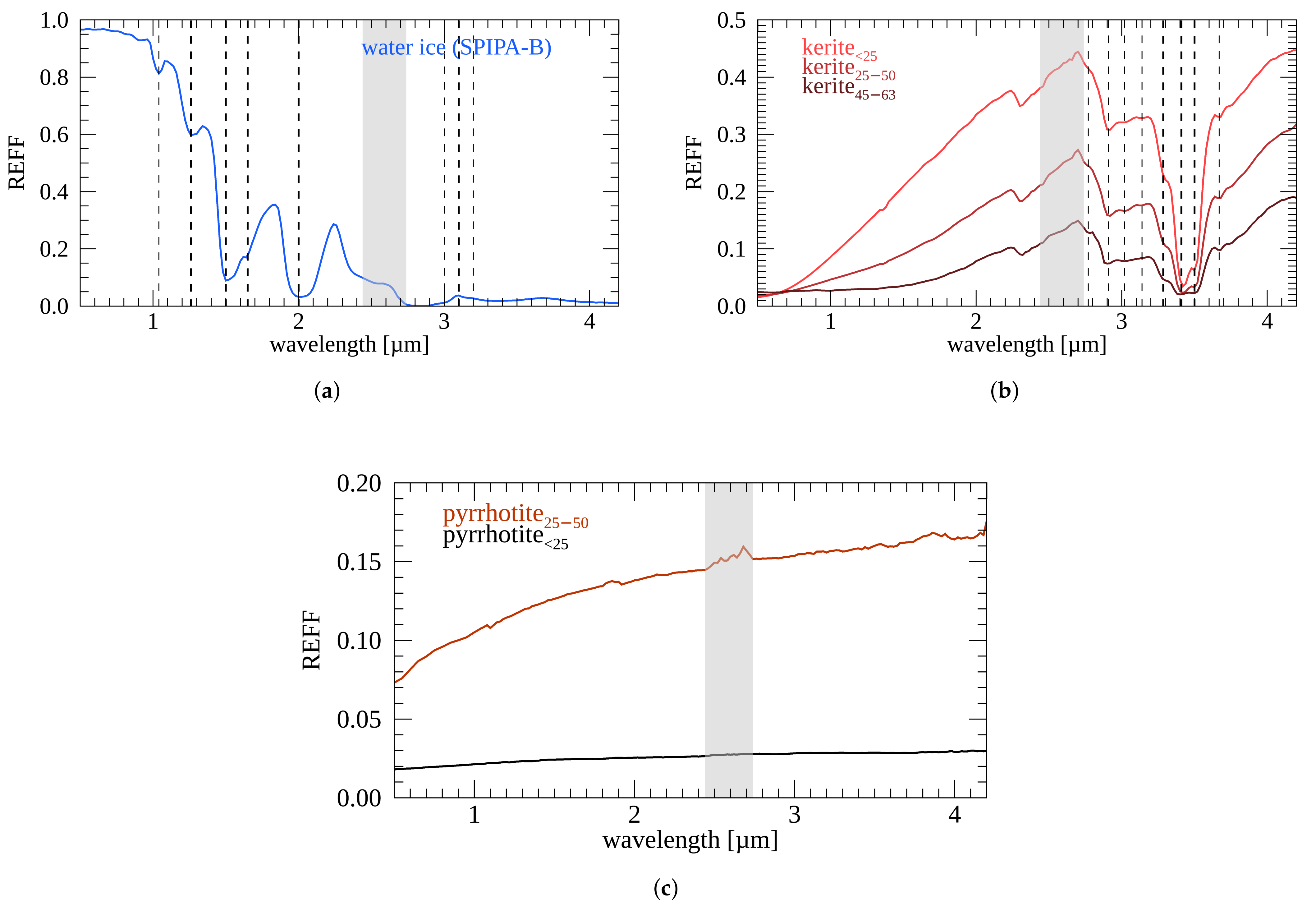
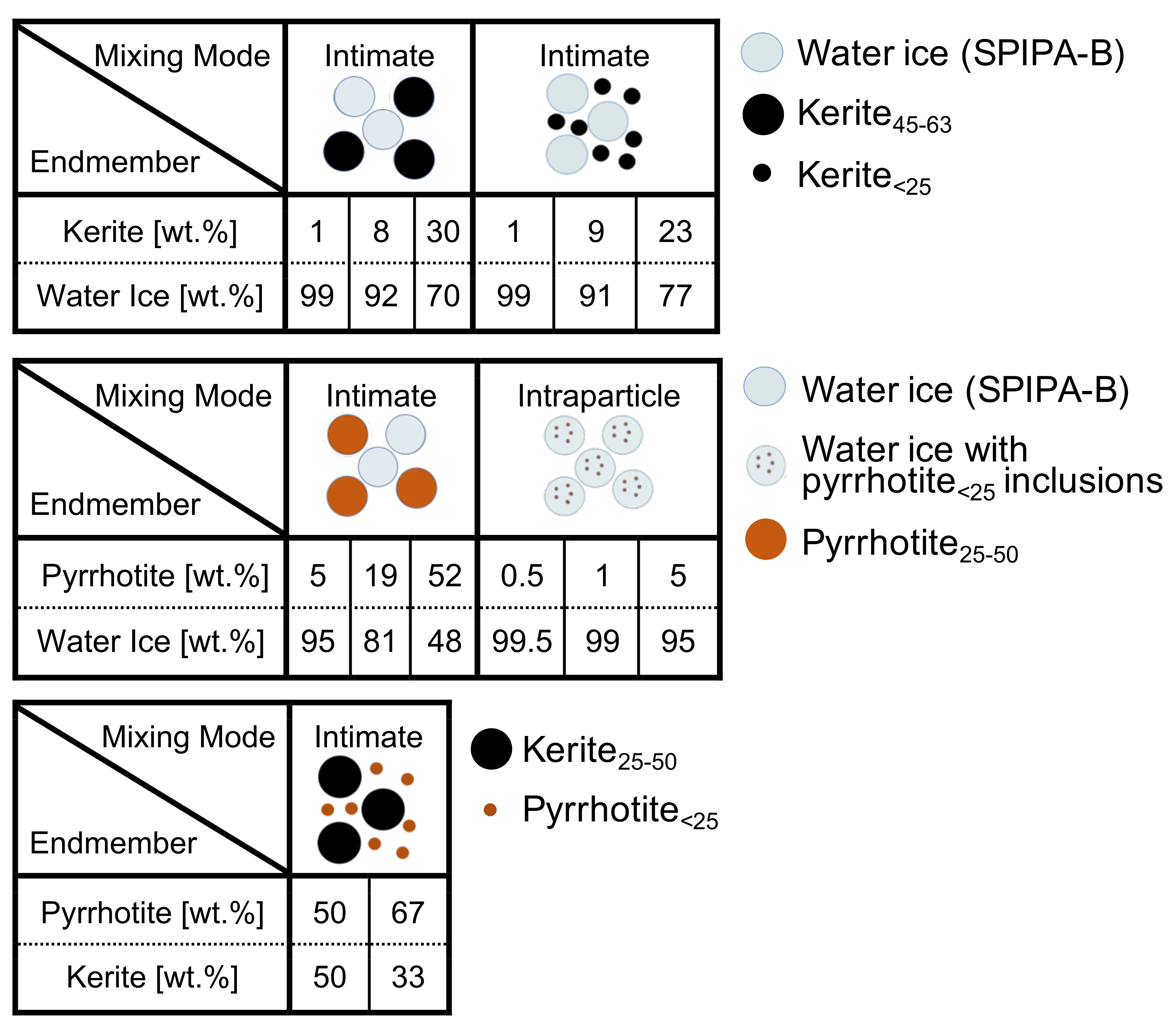


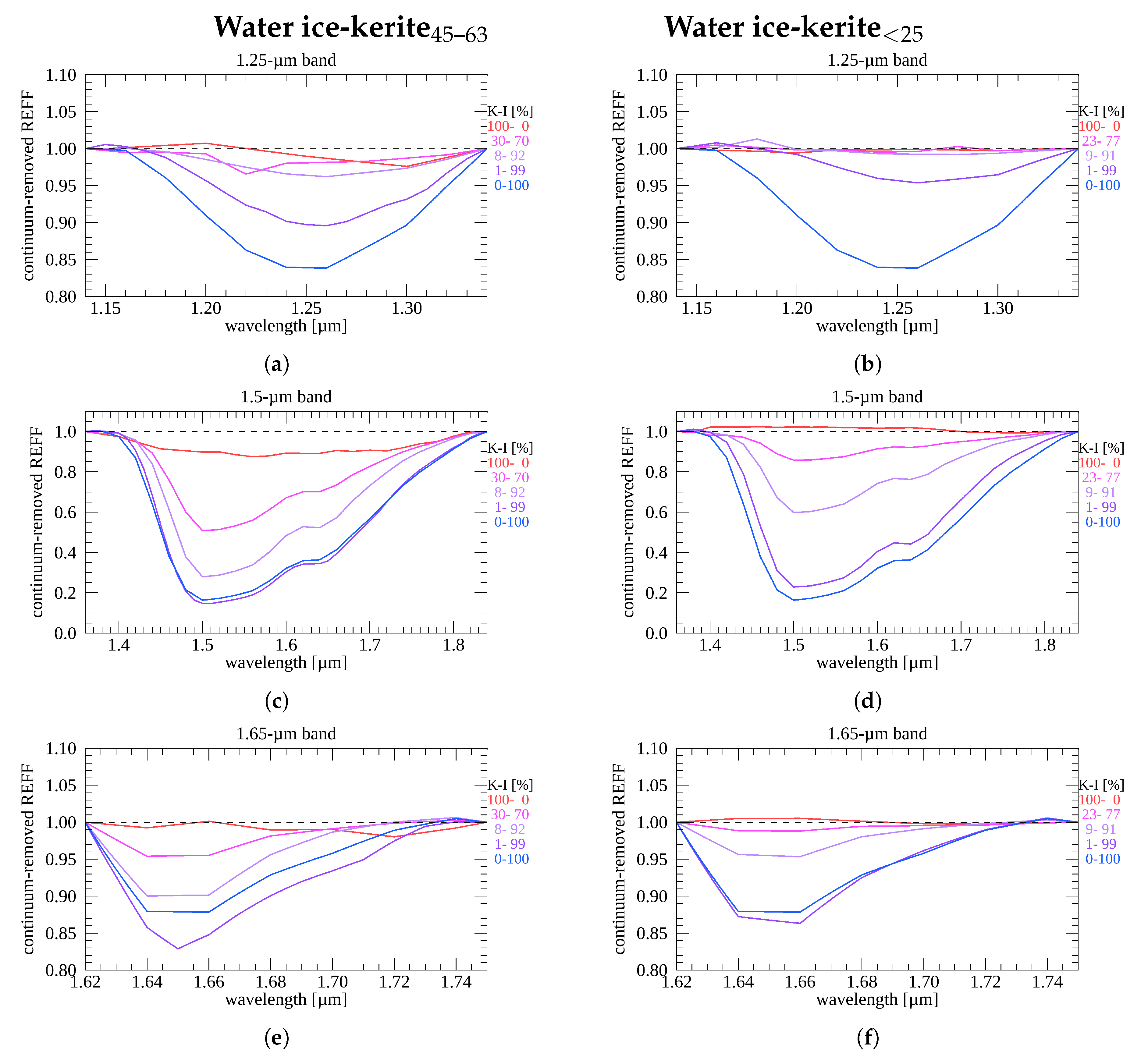
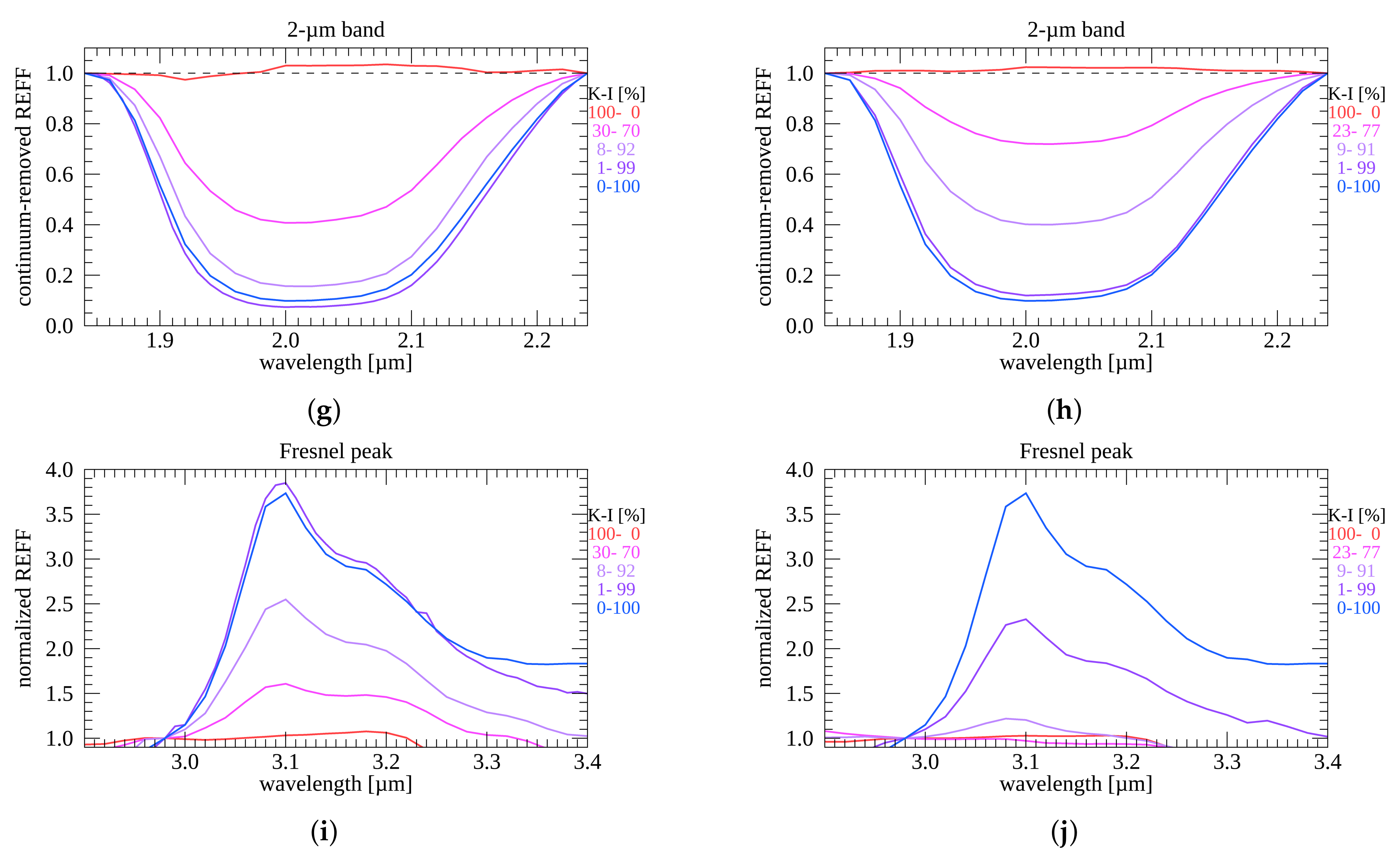
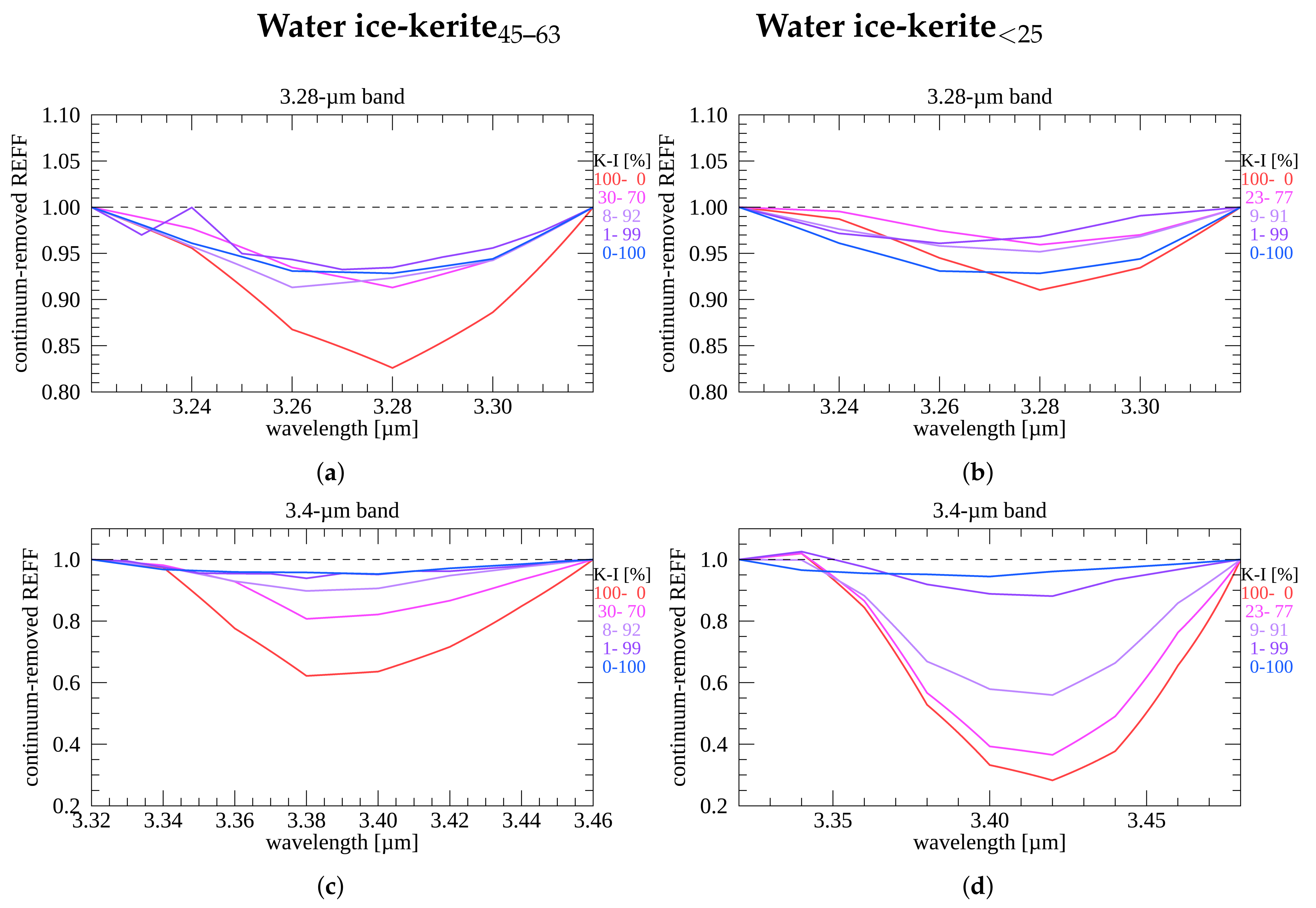


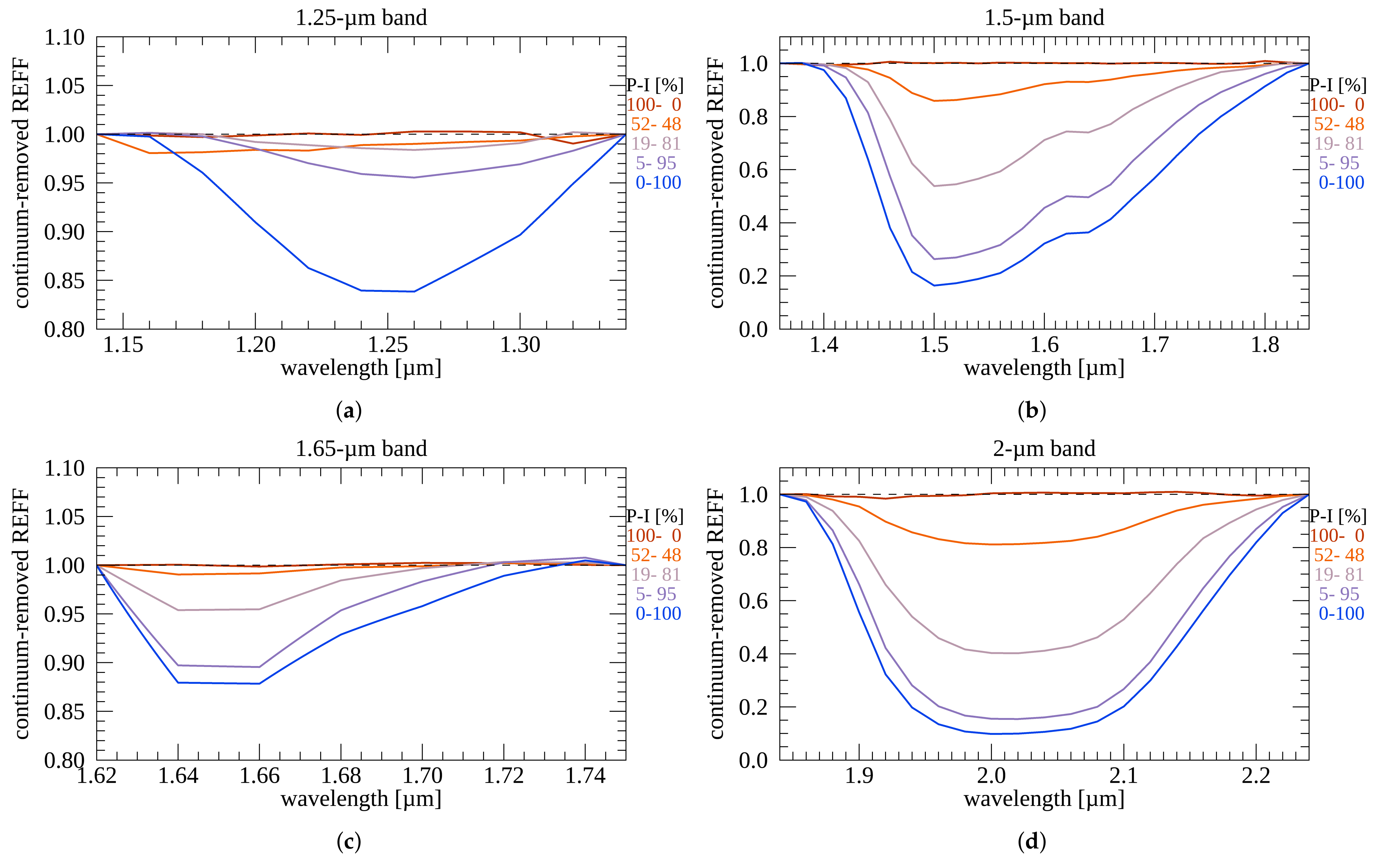
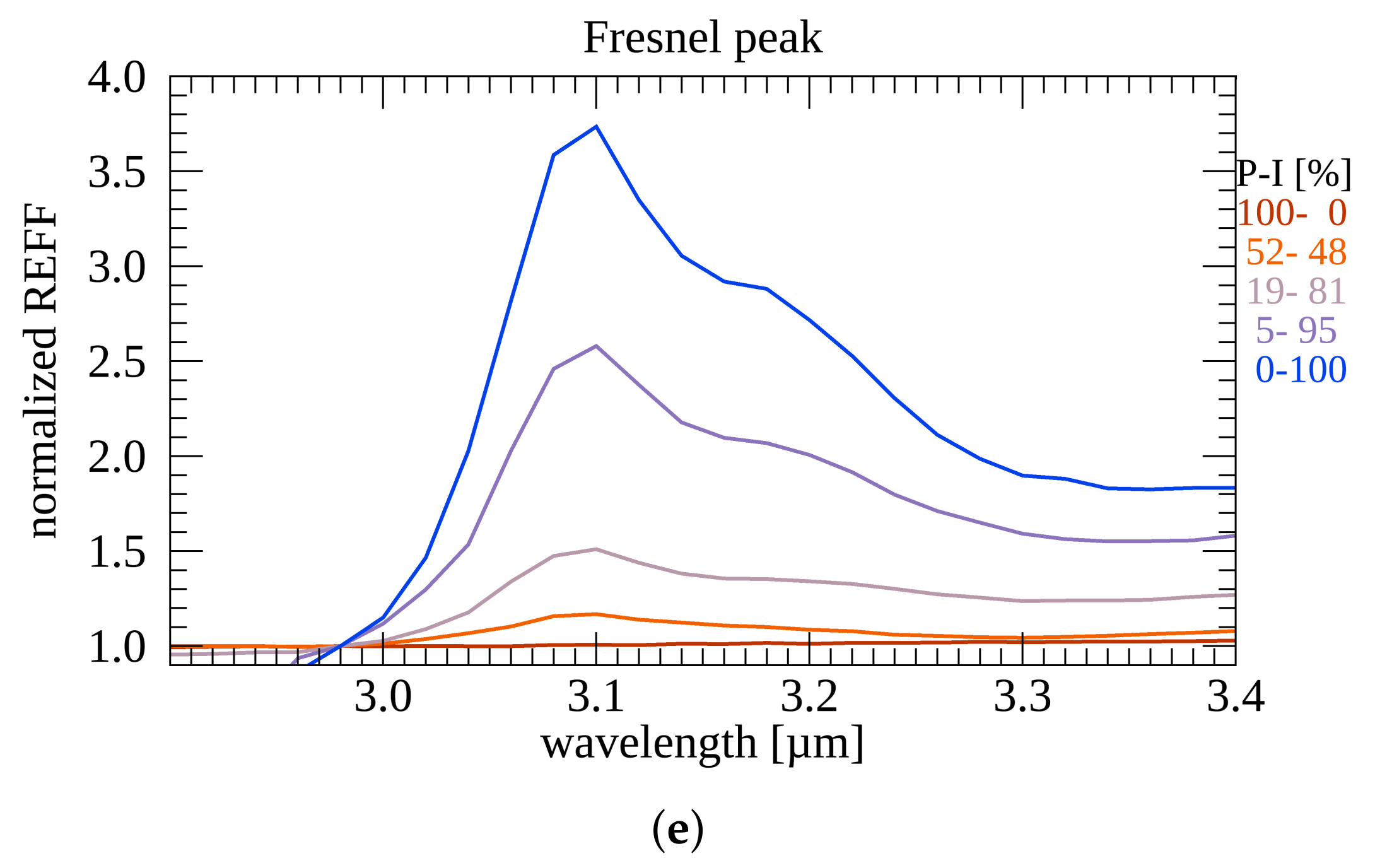

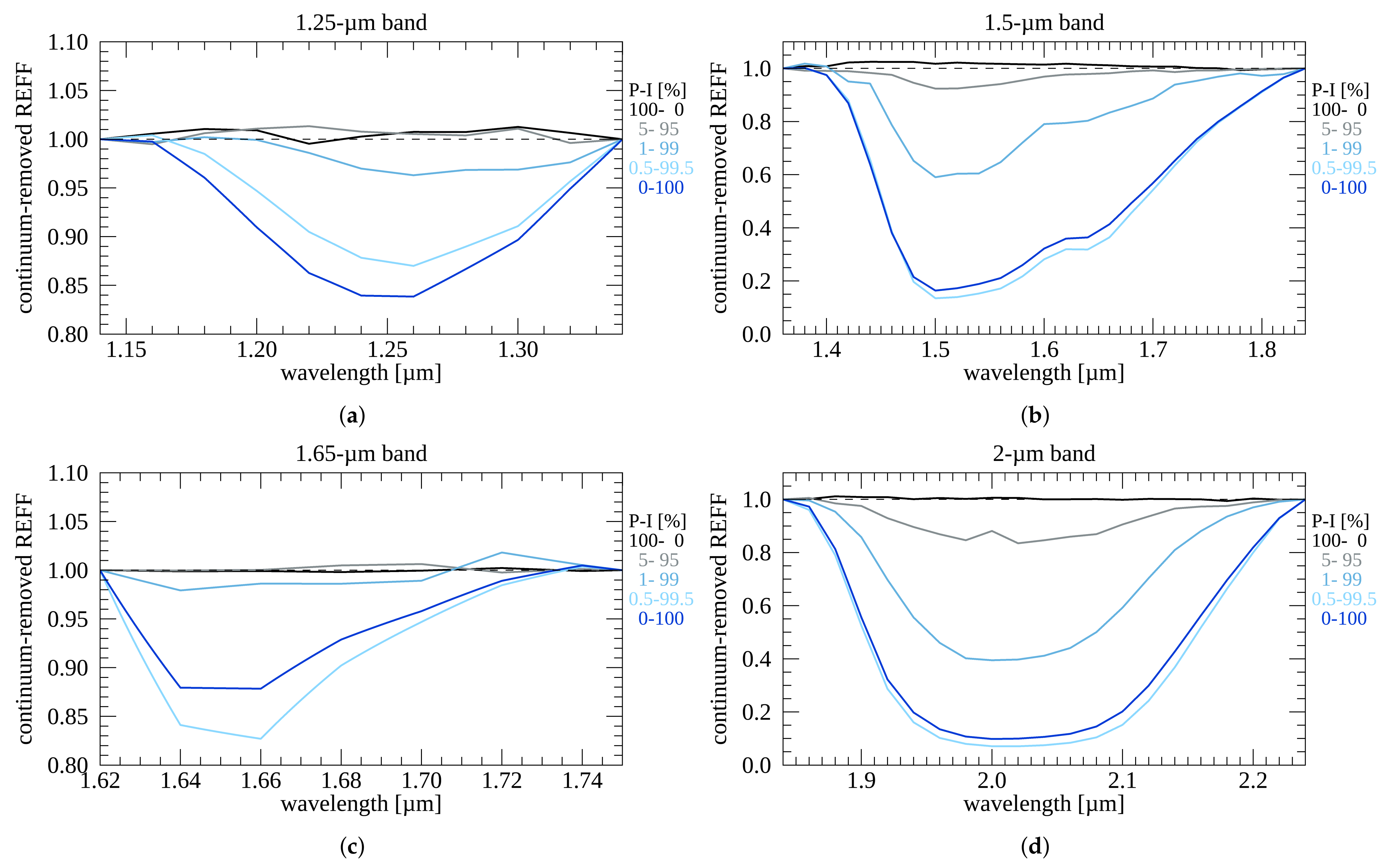
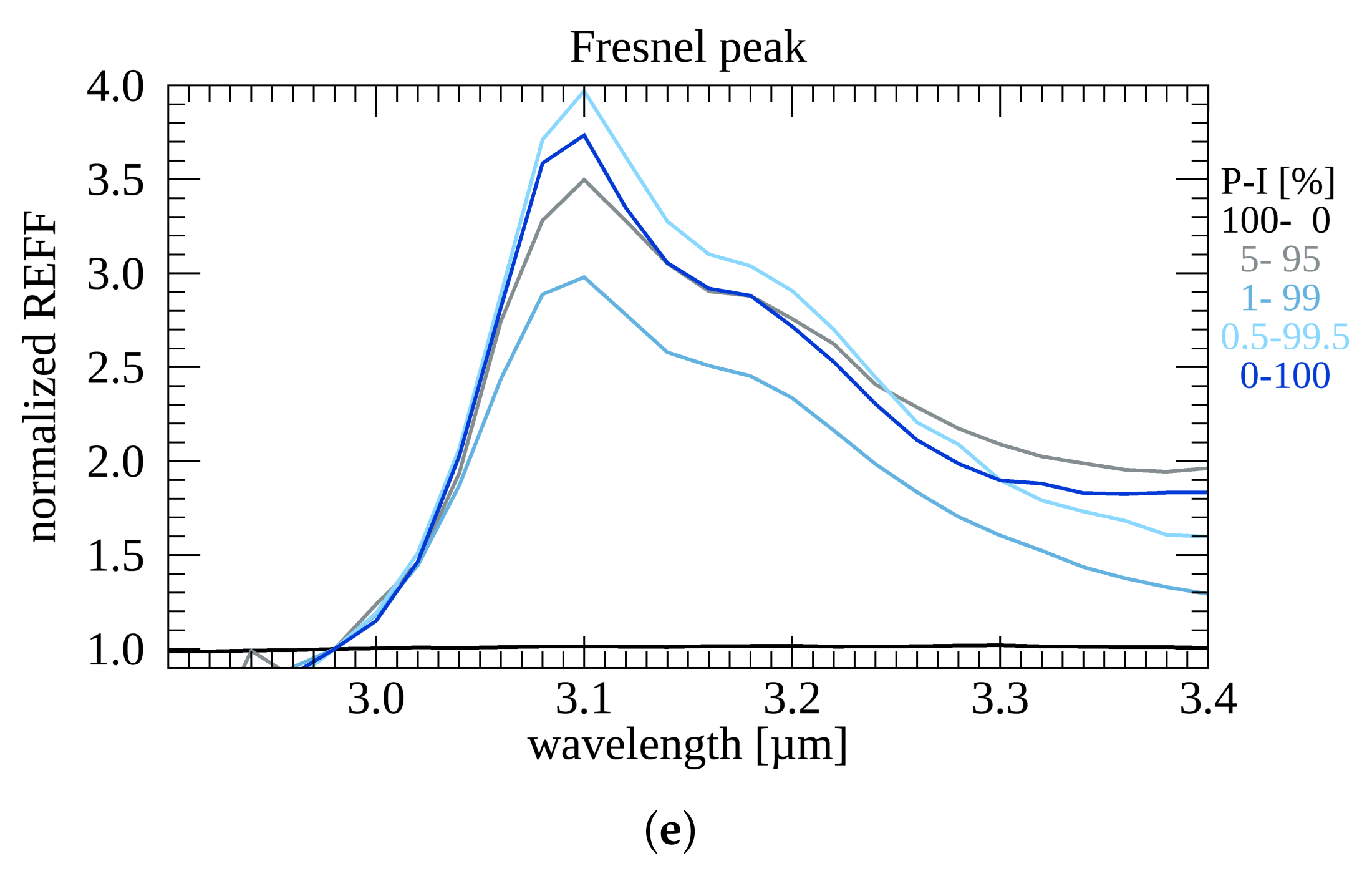
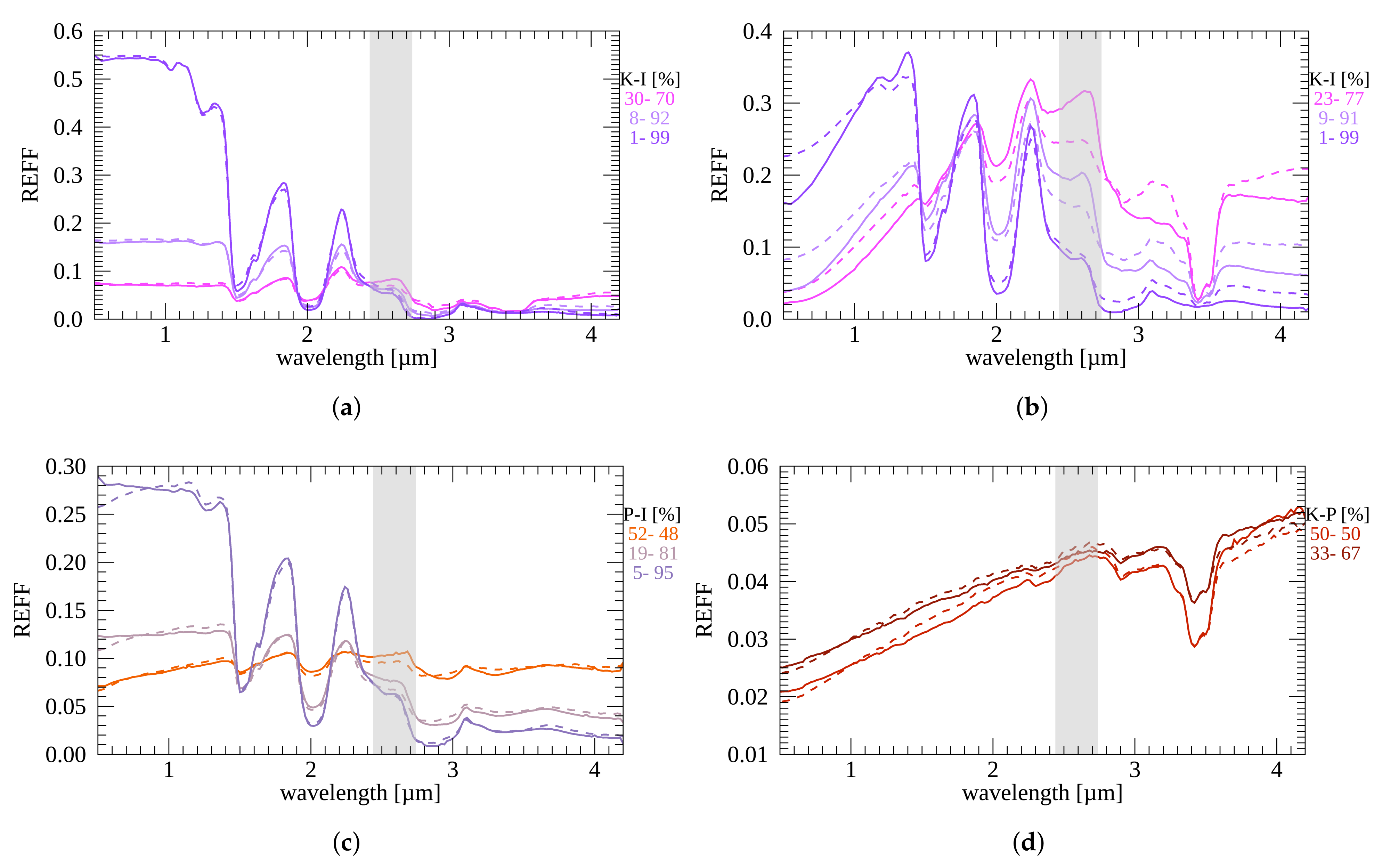
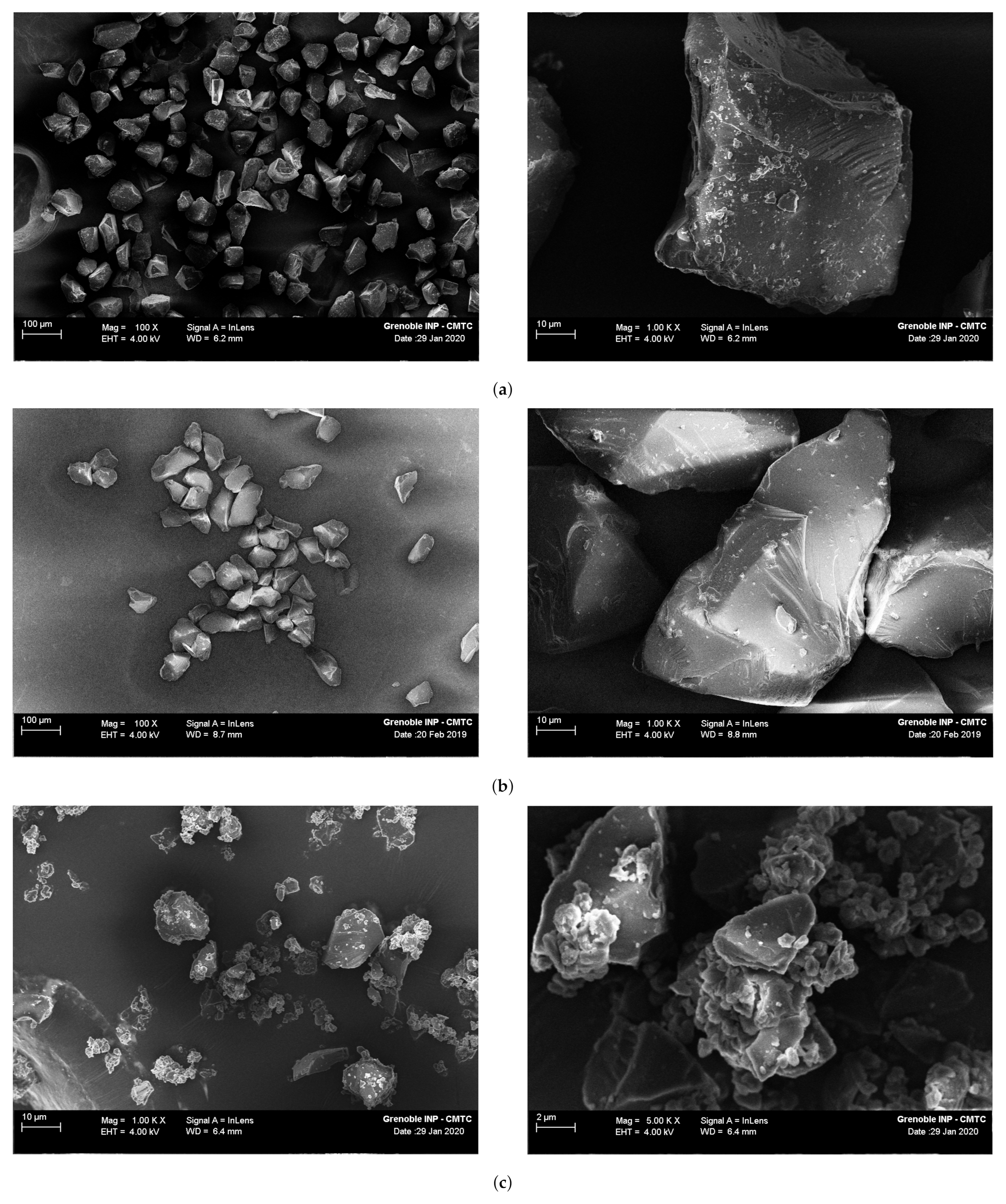
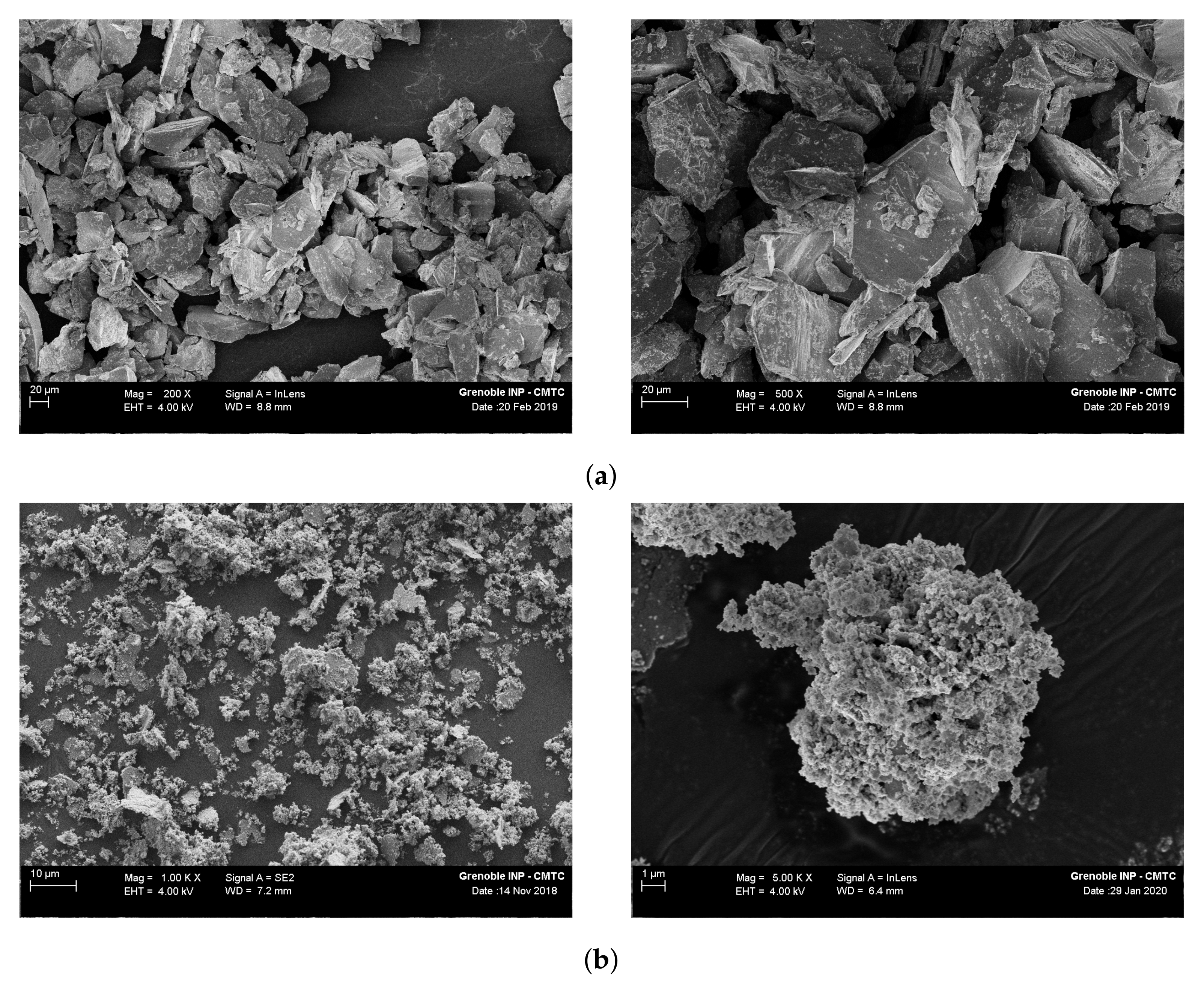
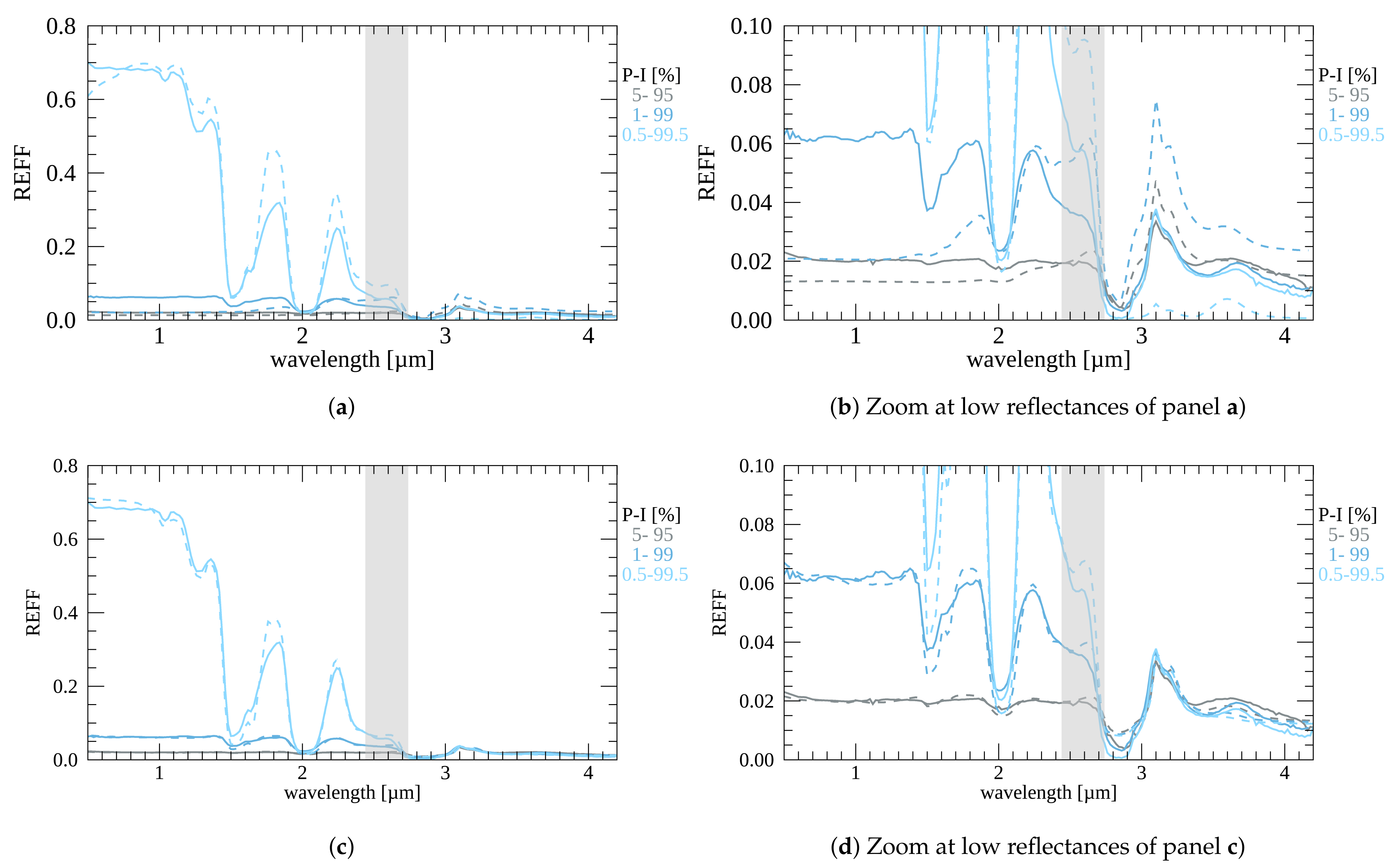
| Water Ice–kerite [wt%]) | C | kerite [m] | NRMSD [%] |
|---|---|---|---|
| 99(98.9)–1(1.1) | 0.79 | 47 | 5 |
| 92(82)–8(18) | 0.67 | 21 | 8 |
| 70(54)–30(46) | 0.66 | 28 | 10 |
| Water Ice–kerite [wt%] | C | kerite [m] | NRMSD [%] |
| 99(96)–1(4) | 0.82 | 3.3 | 16 |
| 91(84)–9(16) | 0.82 | 6.7 | 22 |
| 77(61)–23(39) | 0.86 | 5.8 | 18 |
| Water Ice–pyrrhotite [wt%] | C | pyrrhotite [m] | NRMSD [%] |
| 95(71)–5(29) | 0.69 | 4.9 | 5 |
| 81(34)–19(64) | 0.60 | 4.4 | 6 |
| 48(8)–52(92) | 0.69 | 3.5 | 4 |
| kerite–pyrrhotite [wt%] | C | NRMSD [%] | |
| 50(10)–50(90) | 1.04 | 27 | 5 |
| 33(5)–67(95) | 1.32 | 29 | 3 |
| EMT-Based Model | ||||
|---|---|---|---|---|
| Water Ice-Pyrrhotite [wt%] | p() | [m] | NRMSD [%] | |
| 99.5(99.999)–0.5(0.001) | 0 | 114 | 24 | |
| 99(97)–1(3) | 2.31 | 260 | 69 | |
| 95(92)–5(8) | 1.37 | 162 | 32 | |
| LR11 Model | ||||
| Water Ice-Pyrrhotite [wt%] | p() | [m] | [m] | NRMSD [%] |
| 99.5(99.975 )–0.5(0.025 ) | 1.17 | 222 | 1.7 | 11 |
| 99–1 | 1.23 | 162 | 0.7 | 10 |
| 95–5 | 1.10 | 77 | 0.7 | 11 |
Publisher’s Note: MDPI stays neutral with regard to jurisdictional claims in published maps and institutional affiliations. |
© 2021 by the authors. Licensee MDPI, Basel, Switzerland. This article is an open access article distributed under the terms and conditions of the Creative Commons Attribution (CC BY) license (https://creativecommons.org/licenses/by/4.0/).
Share and Cite
Ciarniello, M.; Moroz, L.V.; Poch, O.; Vinogradoff, V.; Beck, P.; Rousseau, B.; Istiqomah, I.; Sultana, R.; Raponi, A.; Filacchione, G.; et al. VIS-IR Spectroscopy of Mixtures of Water Ice, Organic Matter, and Opaque Mineral in Support of Small Body Remote Sensing Observations. Minerals 2021, 11, 1222. https://doi.org/10.3390/min11111222
Ciarniello M, Moroz LV, Poch O, Vinogradoff V, Beck P, Rousseau B, Istiqomah I, Sultana R, Raponi A, Filacchione G, et al. VIS-IR Spectroscopy of Mixtures of Water Ice, Organic Matter, and Opaque Mineral in Support of Small Body Remote Sensing Observations. Minerals. 2021; 11(11):1222. https://doi.org/10.3390/min11111222
Chicago/Turabian StyleCiarniello, Mauro, Lyuba V. Moroz, Olivier Poch, Vassilissa Vinogradoff, Pierre Beck, Batiste Rousseau, Istiqomah Istiqomah, Robin Sultana, Andrea Raponi, Gianrico Filacchione, and et al. 2021. "VIS-IR Spectroscopy of Mixtures of Water Ice, Organic Matter, and Opaque Mineral in Support of Small Body Remote Sensing Observations" Minerals 11, no. 11: 1222. https://doi.org/10.3390/min11111222
APA StyleCiarniello, M., Moroz, L. V., Poch, O., Vinogradoff, V., Beck, P., Rousseau, B., Istiqomah, I., Sultana, R., Raponi, A., Filacchione, G., Kappel, D., Pommerol, A., Schröder, S. E., Pilorget, C., Quirico, E., Mennella, V., & Schmitt, B. (2021). VIS-IR Spectroscopy of Mixtures of Water Ice, Organic Matter, and Opaque Mineral in Support of Small Body Remote Sensing Observations. Minerals, 11(11), 1222. https://doi.org/10.3390/min11111222










